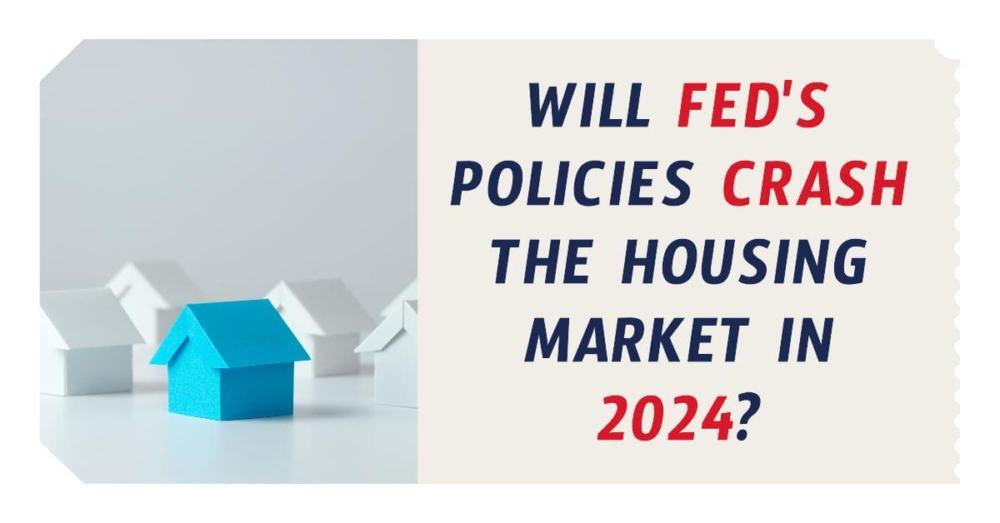As we navigate through April 2024, the financial world has its eyes keenly set on the Federal Reserve’s decision regarding interest rates. This decision is pivotal as it can influence various sectors of the economy, including the housing market. While the Federal Reserve’s decisions on interest rates can influence the housing market, they are not the sole determinant of its performance.
A multitude of economic indicators and market conditions play a role in shaping the housing landscape. Therefore, it is unlikely that the Fed’s decision on interest rates alone would crash the housing market, though it could contribute to a broader economic trend that affects housing prices.
Will the Housing Market Crash if Fed Raises Interest Rates?
The Federal Reserve has maintained the federal funds rate in a range of 5.25% to 5.5%, a decision influenced by the ongoing economic conditions, particularly inflation rates. The housing market, known for its sensitivity to interest rate fluctuations, often reacts to such monetary policy decisions.
Higher interest rates generally lead to higher mortgage rates, which can decrease the affordability of housing and dampen demand. This, in turn, can lead to a slowdown in the housing market, as seen in historical trends. However, the direct correlation between the Fed’s interest rate decisions and a housing market crash is not a given.
Several factors contribute to the dynamics of the housing market, including supply and demand, economic growth, employment rates, consumer confidence, and more. While higher interest rates can make borrowing more expensive, thereby potentially cooling off an overheated market, they do not necessarily lead to a crash. A crash would imply a significant and rapid decline in housing prices, which is usually triggered by a combination of adverse economic factors and not solely by interest rate hikes.
Gradual Approach
The Federal Reserve’s approach to interest rates is typically gradual, aiming to balance the dual mandate of controlling inflation and achieving maximum employment. This gradualism allows the housing market and other interest-sensitive sectors to adjust over time, rather than experiencing abrupt shocks.
Furthermore, the anticipation of interest rate changes often leads to market participants adjusting their behaviors in advance, which can mitigate the impact once the decision is officially announced. For instance, potential homebuyers may rush to lock in lower rates before an expected increase, temporarily boosting demand.
What Are the Federal Reserve’s Interest Rate Policies in 2024?
According to the projections released by the Federal Open Market Committee (FOMC) on March 20, 2024, the median federal funds rate is expected to be 4.6% for the year. This projection is part of the FOMC’s broader economic forecasts, which also include expectations for GDP growth, unemployment, and inflation. These projections are based on current economic conditions, the anticipated path of monetary policy, and other factors that could affect economic outcomes.
The FOMC’s projections suggest a stabilization of the federal funds rate in 2024, with a potential for rate cuts in the following years. The forecast indicates a median policy rate of 3.9% in 2025 and 3.1% in 2026, with a long-run policy rate standing at 2.5%. This gradual reduction aligns with the Fed’s mandate to foster maximum employment and price stability, balancing the need to control inflation while supporting economic growth.
The anticipation of a decrease in the federal funds rate reflects the Fed’s response to the economic environment, including the projected slowdown in GDP growth to 1.4% and a slight rise in the unemployment rate to 4.1% in 2024. Additionally, core PCE inflation is expected to decline to 2.4% in 2024, suggesting that inflationary pressures may ease, allowing for a more accommodative monetary policy stance.
It is important to note that the Federal Reserve’s interest rate policies are not set in stone and can change in response to evolving economic conditions. The Fed continuously monitors a range of economic indicators and adjusts its policy tools accordingly to achieve its dual mandate.
The potential reduction in interest rates could have several implications for the economy. Lower rates typically encourage borrowing and spending, which can stimulate economic activity. For consumers, this might translate into lower mortgage rates and more affordable financing options. For businesses, it could mean easier access to capital for investment and expansion.
However, the impact of interest rate changes is multifaceted and can vary across different sectors and time horizons. While lower rates can boost economic growth, they can also lead to concerns about financial stability and asset bubbles if maintained for too long.
Therefore, the Federal Reserve’s interest rate policies for 2024 indicate a cautious approach, with a focus on supporting economic growth while keeping inflation in check. While the current projections suggest a stabilization and potential reduction in rates, the Fed remains vigilant and ready to adjust its policies as needed to respond to the economic challenges ahead.



